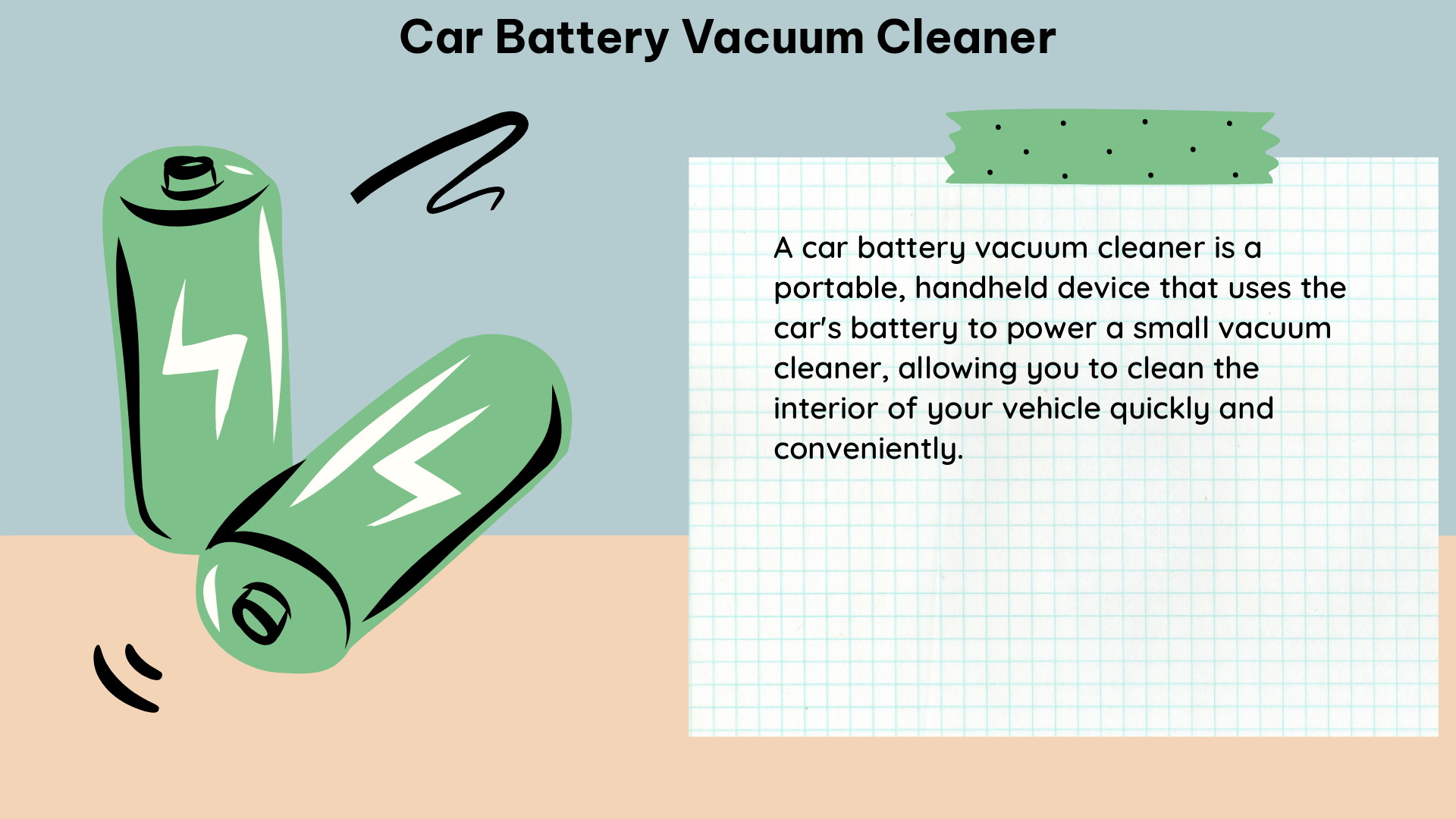The car battery vacuum cleaner is a versatile and convenient cleaning tool designed to tackle the dirt, dust, and debris that accumulate in your vehicle’s interior. Powered by a 12-volt battery, this compact device offers a hassle-free way to maintain a clean and well-kept car without the need for a traditional power outlet.
Understanding the Mechanics of Car Battery Vacuum Cleaners
At the heart of a car battery vacuum cleaner is a powerful motor that generates suction, typically ranging from 80 to 120 watts. This motor is powered by a 12-volt DC connection, which allows the device to be plugged directly into your car’s auxiliary outlet or cigarette lighter socket.
The suction power of these vacuum cleaners is measured in air watts (AW), a metric that takes into account both the airflow and the vacuum pressure generated by the motor. High-end models can achieve suction levels of up to 100 AW, providing ample power to pick up a variety of debris, from crumbs and pet hair to larger particles.
To ensure efficient and thorough cleaning, car battery vacuum cleaners often come equipped with a range of specialized attachments, such as:
- Crevice Tool: Designed for reaching tight spaces and corners, the crevice tool allows you to clean between seats, along door panels, and in other hard-to-reach areas.
- Brush Attachment: The brush attachment helps agitate and loosen embedded dirt and dust, making it easier for the suction to capture and remove the debris.
- Extension Hose: An extension hose provides additional reach, enabling you to clean the entire cabin of your vehicle without having to constantly reposition the vacuum.
- HEPA Filter: Many car battery vacuum cleaners feature a HEPA (High-Efficiency Particulate Air) filter, which traps 99.97% of airborne particles as small as 0.3 microns, ensuring cleaner exhaust air.
Maximizing Battery Life and Efficiency

One of the key considerations when using a car battery vacuum cleaner is the impact on your vehicle’s battery. While these devices are designed to have a relatively low power draw, prolonged use with the engine off can still drain the battery over time.
To optimize battery life and efficiency, it’s recommended to follow these guidelines:
- Run the Engine: Whenever possible, run your car’s engine while using the vacuum cleaner. This will ensure that the alternator is charging the battery, preventing significant discharge.
- Monitor Battery Levels: Keep a close eye on your car’s battery level, and avoid using the vacuum cleaner if the battery is already low. This will help prevent the battery from being drained to the point of being unable to start the vehicle.
- Limit Usage Duration: Avoid prolonged, continuous use of the vacuum cleaner. Instead, break up cleaning sessions into shorter bursts to minimize the impact on the battery.
- Consider Battery Capacity: If you have an older or weaker car battery, you may need to be more cautious with the vacuum cleaner’s usage to avoid potential issues.
Maintaining and Cleaning the Vacuum Cleaner
To ensure the longevity and optimal performance of your car battery vacuum cleaner, it’s essential to maintain and clean the device regularly. Here are some key maintenance tips:
- Filter Cleaning: Regularly clean or replace the HEPA filter according to the manufacturer’s instructions. A clogged filter can reduce suction power and airflow.
- Attachment Cleaning: Wipe down the various attachments, such as the crevice tool and brush, to remove any accumulated dirt or debris.
- Exterior Cleaning: Gently wipe down the exterior of the vacuum cleaner with a damp cloth to keep it looking clean and well-maintained.
- Storage: When not in use, store the vacuum cleaner in a dry, cool place to prevent any damage or deterioration.
Choosing the Right Car Battery Vacuum Cleaner
When selecting a car battery vacuum cleaner, consider the following factors to ensure you get the best fit for your needs:
- Suction Power: Opt for a model with a higher air watt (AW) rating, as this will provide more effective cleaning power.
- Attachments: Look for a vacuum cleaner that comes with a variety of attachments, such as the crevice tool and brush, to tackle different cleaning tasks.
- Battery Life: Check the runtime specifications to ensure the vacuum cleaner can handle your cleaning needs without draining the car’s battery too quickly.
- Noise Level: Some vacuum cleaners are designed to operate more quietly than others, which can be a consideration if you value a peaceful cleaning experience.
- Portability: Look for a lightweight and compact design that is easy to maneuver and store in your vehicle.
Conclusion
The car battery vacuum cleaner is a versatile and convenient cleaning tool that can help you maintain a spotless interior in your vehicle. By understanding the mechanics, maximizing battery efficiency, and properly maintaining the device, you can enjoy a hassle-free and effective cleaning experience. Whether you’re tackling a quick cleanup or a thorough detailing session, a car battery vacuum cleaner can be a valuable addition to your automotive care arsenal.
References:
- Car Battery Vacuum Cleaner Patent
- How Vacuum Cleaners Affect Car Batteries
- Auto Joe ATJ-V501 Car Vacuum Cleaner

The lambdageeks.com Core SME Team is a group of experienced subject matter experts from diverse scientific and technical fields including Physics, Chemistry, Technology,Electronics & Electrical Engineering, Automotive, Mechanical Engineering. Our team collaborates to create high-quality, well-researched articles on a wide range of science and technology topics for the lambdageeks.com website.
All Our Senior SME are having more than 7 Years of experience in the respective fields . They are either Working Industry Professionals or assocaited With different Universities. Refer Our Authors Page to get to know About our Core SMEs.